
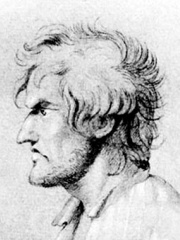


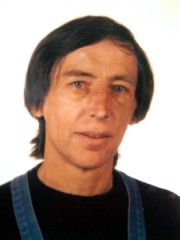
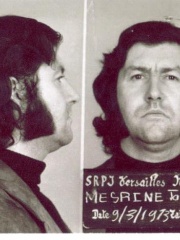
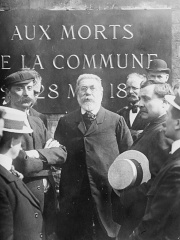
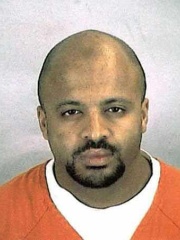
The Most Famous
EXTREMISTS from France
This page contains a list of the greatest French Extremists. The pantheon dataset contains 283 Extremists, 10 of which were born in France. This makes France the birth place of the 5th most number of Extremists behind Germany, and Italy.
Top 10
The following people are considered by Pantheon to be the top 10 most legendary French Extremists of all time. This list of famous French Extremists is sorted by HPI (Historical Popularity Index), a metric that aggregates information on a biography's online popularity. Visit the rankings page to view the entire list of French Extremists.

1. Gilles de Rais (1405 - 1440)
With an HPI of 76.41, Gilles de Rais is the most famous French Extremist. His biography has been translated into 37 different languages on wikipedia.
Gilles de Rais, Baron de Rais (French: [ʒil də ʁɛ]; also spelled "Retz"; c. 1405 – 26 October 1440) was a French knight and lord from Brittany, Anjou and Poitou, a leader in the French army during the Hundred Years' War, and a companion-in-arms of Joan of Arc. He remains chiefly known for his conviction on charges of the rape and murder of several children. An important lord as heir to some great noble lineages of western France, he rallied to the cause of King Charles VII of France and waged war against the English. In 1429, he formed an alliance with his cousin Georges de La Trémoille, the prominent Grand Chamberlain of France, and was appointed Marshal of France the same year, after the successful military campaigns alongside Joan of Arc. Little is known about his relationship with her, unlike the privileged association between the two comrades in arms portrayed by various fictions. He gradually withdrew from the war during the 1430s. His family accused him of squandering his patrimony by selling off his lands to the highest bidder to offset his lavish expenses, a profligacy that led to his being placed under interdict by Charles VII in July 1435. He assaulted a high-ranking cleric in the church of Saint-Étienne-de-Mer-Morte before seizing the local castle in May 1440, thereby violating ecclesiastical immunities and undermining the majesty of his suzerain, John V, Duke of Brittany. Arrested on 15 September 1440 at his castle in Machecoul, he was brought to the Duchy of Brittany, an independent principality where he was tried in October 1440 by an ecclesiastical court assisted by the Inquisition for heresy, sodomy and the murder of "one hundred and forty or more children." At the same time, he was tried and condemned by the secular judges of the ducal court of justice to be hanged and burned at the stake for his act of force at Saint-Étienne-de-Mer-Morte, as well as for crimes committed against "several small children." On 26 October 1440, he was sent to the scaffold with two of his servants convicted of murder. A popular confusion between the mythical Bluebeard and the historical Baron de Rais has been documented since the early 19th century, regardless of the uncertain hypothesis that Gilles de Rais served as an inspiration for Charles Perrault's "Bluebeard" literary fairy tale (1697). Furthermore, in the aftermath of the late 19th century reconceptualization of the phenomenon of serial sexual crime, the case of Gilles de Rais has often been interpreted within the criminological framework of the serial killer, although such a categorization is at times regarded as anachronistic. The vast majority of historians believe he was guilty, but some advise caution when reviewing historical trial proceedings. Medievalists Jacques Chiffoleau and Claude Gauvard note the need to study the inquisitorial procedure employed by questioning the defendants' confessions in the light of the judges' expectations and conceptions, while also examining the role of rumor in the development of Gilles de Rais's fama publica (renown), without disregarding detailed testimonies concerning the disappearance of children, or confessions describing murderous rituals unparalleled in the judicial archives of the time.

2. Robert-François Damiens (1715 - 1757)
With an HPI of 70.15, Robert-François Damiens is the 2nd most famous French Extremist. His biography has been translated into 26 different languages.
Robert-François Damiens (French pronunciation: [ʁɔbɛʁ fʁɑ̃swa damjɛ̃]; surname also recorded as Damier, [damje]; 9 January 1715 – 28 March 1757) was a French domestic servant whose attempted assassination of King Louis XV in 1757 culminated in his public execution. He was the last person to be executed in France by dismemberment, the traditional form of death penalty reserved for regicides.

3. Henri Désiré Landru (1869 - 1922)
With an HPI of 67.26, Henri Désiré Landru is the 3rd most famous French Extremist. His biography has been translated into 23 different languages.
Henri Désiré Landru (12 April 1869 – 25 February 1922) (French pronunciation: [ɑ̃ʁi deziʁe lɑ̃dʁy]) was a French serial killer, nicknamed the Bluebeard of Gambais and a prolific marriage fraudster. He is confirmed to have murdered at least ten women and the teenage son of his first victim, primarily targeting lonely war widows whom he met through newspaper advertisements, seduced, defrauded of their assets, and then killed, disposing of their bodies by burning them in his stove. He committed these crimes between December 1914 and January 1919, first at a house in Vernouillet and later at an isolated villa in Gambais, near Paris. The true number of Landru's victims remains unknown, as police traced correspondence with 283 women, 72 of whom were never found. He is considered one of France's most famous and notorious murderers, whose investigation and trial became a media sensation in the aftermath of World War I. His case served as the inspiration for Charlie Chaplin's film Monsieur Verdoux. Landru was arrested on 12 April 1919 at an apartment near Paris's Gare du Nord, which he shared with his 24-year-old mistress Fernande Segret. Police eventually concluded that Landru had met or been in romantic correspondence with 283 women during the First World War, meticulously categorized by their potential wealth; seventy-two were never traced. In December 1919, Landru's wife Marie-Catherine, 51, and his eldest son Maurice, 25, were arrested on suspicion of complicity in Landru's thefts from his victims. Both denied any knowledge of Landru's criminal activities. Marie-Catherine was released without charge in July 1920 for health reasons. Maurice was released on the same day because the authorities could not establish his guilt. Landru's trial in November 1921 at Versailles garnered immense public attention, attracting celebrities like Colette and Maurice Chevalier. Although he maintained his innocence and despite the lack of bodies, he was found guilty of eleven murders by a majority verdict on 30 November 1921, largely based on his meticulous notebooks and the circumstantial evidence. He was executed by guillotine on 25 February 1922.

4. Jean II, Duke of Alençon (1409 - 1476)
With an HPI of 66.76, Jean II, Duke of Alençon is the 4th most famous French Extremist. His biography has been translated into 20 different languages.
Jean II of Alençon (Jean II d’Alençon) (2 March 1409 – 8 September 1476) was a French nobleman. He succeeded his father as Duke of Alençon and Count of Perche as a minor in 1415, after the latter's death at the Battle of Agincourt. He is best known as a general in the last phase of the Hundred Years' War and for his role as a comrade-in-arms of Joan of Arc.
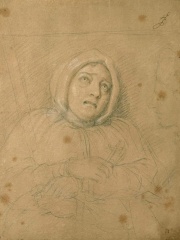
5. Madame de Brinvilliers (1630 - 1676)
With an HPI of 66.00, Madame de Brinvilliers is the 5th most famous French Extremist. Her biography has been translated into 18 different languages.
Marie-Madeleine d'Aubray, Marquise de Brinvilliers (French: [bʁɛ̃vilje]; 22 July 1630 – 16 July 1676) was a French aristocrat who was convicted of murdering her father and two of her brothers in order to inherit their estates. After her death, there was speculation that she tested her poisons on upwards of 30 sick people in hospitals, but these rumours were never confirmed. Her crimes were discovered after the death of her lover and co-conspirator, Captain Godin de Sainte-Croix, who saved letters detailing dealings of poisonings between the two. After being arrested, she was tortured, forced to confess, and finally executed. Her trial and death spawned the onset of the Affair of the Poisons, a major scandal during the reign of Louis XIV accusing aristocrats of practising witchcraft and poisoning people. Components of her life have been adapted into various media including short stories, poems, and songs to name a few.

6. Michel Fourniret (1942 - 2021)
With an HPI of 64.63, Michel Fourniret is the 6th most famous French Extremist. His biography has been translated into 19 different languages.
Michel Paul Fourniret (4 April 1942 – 10 May 2021) was a French serial killer who confessed to killing 12 people in France and Belgium between 1987 and 2003. After he was arrested in June 2003 for the attempted kidnapping of a teenage girl in Ciney, Fourniret confessed in 2004 to killing nine people, eight females and one male, having been informed on by his then-wife, Monique Pierrette Olivier (born 31 October 1948). Fourniret was convicted of seven of these murders on 28 May 2008 and sentenced to life imprisonment without possibility of parole, while Olivier was given life with a minimum term of 28 years for complicity. In February 2018, Fourniret confessed to killing two more women. On 16 November 2018, Fourniret and Olivier were convicted of the murder of Farida Hammiche, the last of the eight women that Fourniret confessed to killing in 2004. Fourniret was given a second life sentence and Olivier was sentenced to a further 20 years of imprisonment. In March 2020, Fourniret confessed to killing Estelle Mouzin, who disappeared from Guermantes in 2003.

7. Jacques Mesrine (1936 - 1979)
With an HPI of 62.41, Jacques Mesrine is the 7th most famous French Extremist. His biography has been translated into 21 different languages.
Jacques Mesrine (French pronunciation: [ʒak mɛʁin, mɛsʁin]; 28 December 1936 – 2 November 1979) was a French criminal responsible for numerous murders, bank robberies, burglaries, and kidnappings in France, the US, and Canada. Mesrine repeatedly escaped from prison and made international headlines during a final period as a fugitive when his exploits included trying to kidnap the judge who had previously sentenced him. An aptitude for disguise earned him the moniker "The Man of a Thousand Faces" and enabled him to remain at large while receiving massive publicity as a wanted man. Mesrine was widely seen as an anti-establishment Robin Hood figure. In keeping with his charismatic image, he was rarely without a glamorous female companion. A two-part film, Mesrine, which came out in 2008, was based on Mesrine's life.

8. Édouard Vaillant (1840 - 1915)
With an HPI of 55.25, Édouard Vaillant is the 8th most famous French Extremist. His biography has been translated into 16 different languages.
Marie Édouard Vaillant (26 January 1840 – 18 December 1915) was a French politician. Born in Vierzon, Cher, son of a lawyer, Édouard Vaillant studied engineering at the École Centrale des Arts et Manufactures, graduating in 1862, and then law at the Sorbonne. In Paris he knew Charles Longuet, Louis-Auguste Rogeard, and Jules Vallès. A reader of Pierre-Joseph Proudhon's writings, he met Proudhon, and joined the International Workingmen's Association. He went to study in Germany in 1866. At the outbreak of the Franco-Prussian War in 1870 he returned to Paris. It was during the Siege of Paris that Vaillant met Auguste Blanqui. Vaillant opposed the Government of National Defence, and took part in the revolts on 31 October 1870 and 22 January 1871. He was one of the four editors of the Affiche Rouge (red poster) calling for the creation of the Paris Commune. In the elections of February 1871 he stood as a revolutionary socialist candidate for the National Assembly but was not elected. In March 1871 he was elected by the 20th arrondissement to the council of the Commune where he oversaw work on education. Following the bloody suppression of the Commune in late May 1871, Vaillant fled France with Eugène Baudin for Great Britain where he was part of the Blanquist tendency of the First International. He was sentenced to death in absentia in July 1872 and did not return to France until the general amnesty of 1880. Active in socialist politics, Vaillant was elected to the Chamber of Deputies in 1893, representing the 20th arrondissement. Although he had earlier been a convinced revolutionary, in the Chamber he generally followed a middle ground between the "revolutionaries" represented by Jules Guesde and the "reformists" represented by Jean Jaurès. He was among the founder members of the French Section of the Workers' International (SFIO), a socialist party uniting revolutionary and reformist groups. Vaillant supported a general strike to prevent French participation in the First World War, but following the assassination of Jaurès and the outbreak of war, he joined the majority of socialists in supporting the Union sacrée and harshly criticised pacifist members of the SFIO in his speeches. Édouard Vaillant died in Paris on 18 December 1915. Schools in his birthplace of Vierzon, and in Gennevilliers, are named in his honour.

9. Zacarias Moussaoui (b. 1968)
With an HPI of 54.21, Zacarias Moussaoui is the 9th most famous French Extremist. His biography has been translated into 24 different languages.
Zacarias Moussaoui (Arabic: زكريا موسوي, Zakariyyā Mūsawī; born 30 May 1968) is a French Arab member of al-Qaeda who pleaded guilty in a U.S. federal court to conspiring to kill citizens of the United States as part of the 9/11 attacks. He is serving life imprisonment without the possibility of parole at the Federal ADX Supermax prison in Florence, Colorado. Moussaoui is the only person ever convicted in a U.S. court in connection with the September 11 attacks.

10. Yvan Colonna (1960 - 2022)
With an HPI of 51.84, Yvan Colonna is the 10th most famous French Extremist. His biography has been translated into 18 different languages.
Yvan Colonna (Corsican: Ivanu Colonna, [iˈvanu koˈlɔnna]; 7 April 1960 – 21 March 2022) was a Corsican nationalist convicted for the 1998 assassination of the prefect of Corse-du-Sud, Claude Érignac. He was beaten to death in prison by another inmate for "disrespecting Muhammad", sparking riots.
People
Pantheon has 10 people classified as French extremists born between 1405 and 1968. Of these 10, 1 (10.00%) of them are still alive today. The most famous living French extremists include Zacarias Moussaoui. The most famous deceased French extremists include Gilles de Rais, Robert-François Damiens, and Henri Désiré Landru.
Living French Extremists
Go to all RankingsDeceased French Extremists
Go to all RankingsGilles de Rais
1405 - 1440
HPI: 76.41
Robert-François Damiens
1715 - 1757
HPI: 70.15
Henri Désiré Landru
1869 - 1922
HPI: 67.26
Jean II, Duke of Alençon
1409 - 1476
HPI: 66.76
Madame de Brinvilliers
1630 - 1676
HPI: 66.00
Michel Fourniret
1942 - 2021
HPI: 64.63
Jacques Mesrine
1936 - 1979
HPI: 62.41
Édouard Vaillant
1840 - 1915
HPI: 55.25
Yvan Colonna
1960 - 2022
HPI: 51.84
Overlapping Lives
Which Extremists were alive at the same time? This visualization shows the lifespans of the 6 most globally memorable Extremists since 1700.

